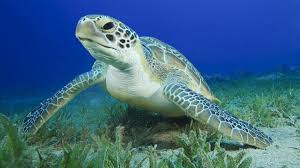Each year, the number of sea turtles dwindles. Worldwide, six out of the seven species of sea turtles are listed as threatened or endangered. Sea turtles are one of the many animals whose populations are suffering due to the warming of the earth. When CO2 levels rise, the atmosphere heats up, warming the entire globe. In the ocean, global warming warms the temperature of sand. When sea turtles lay eggs on beaches, the temperature of the sand surrounding the egg determines the gender of the offspring, which is known as temperature-dependant sex determination. Warm sand causes sea turtles to be born female, whereas cooler sand causes them to be born male. In ideal conditions, the eggs that are layed deeper in the sand would be all males, and the eggs closer to the surface of the sand would be female, creating an equal number of male and female turtles.
As the sand heats up, almost all the eggs in sea turtles’ nests are being born female. This large population of female sea turtles is detrimental for the survival of sea turtle species because without many male turtles, the number of mated pairs of turtles has dropped significantly. This causes fewer and fewer eggs to be hatched each year. Out of every nest of approximately 300 eggs, only one or two sea turtles actually survive to reproduce. If the temperature of the surface of the earth continues to rise, sea turtles will eventually become extinct as no more males will be born.
When asked about the fourth national climate assessment, which is a 1,500-page two-part congressionally mandated report by the U.S. Global Change Research Program, President Donald Trump stated, “I don’t believe it.” Many Republican officials have agreed with Trump, giving explanations such as “the climate is always changing,” “many scientists are driven by money,” and “if climate change is real, it is not caused by man-made pollutants.”
The rapid change in the percentage of male versus female sea turtles alone shows that the temperature of the earth is rising. Other evidence of climate change is demonstrated in shrinking glaciers around the world and ice sheets in Greenland and Antarctica. A Global Climate Change article published by NASA states that “data from NASA’s Gravity Recovery and Climate Experiment show Greenland lost an average of 281 billion tons of ice per year between 1993 and 2016, while Antarctica lost about 119 billion tons during the same time period.” In the arctic, declining amounts of sea ice caused by the warming of ocean temperatures threatens many populations. For example, during their first six weeks of life, Harp seals use ice to rest and nurse on, and young seals find their food along the edges of the ice. As the ice melts, these pups are forced into the water, where they are at risk of hypothermia and starvation.
Climate change is a real, serious problem that will continue to affect many populations. To help slow the warming of the earth, people can help emit less CO2 into the atmosphere by recycling, unplugging devices when unnecessary, driving less, and using public transportation. Even though it seems like a minor contribution to a major problem, each person can have an impact and can help to save these populations threatened by climate change.

